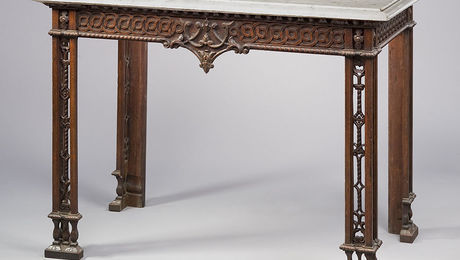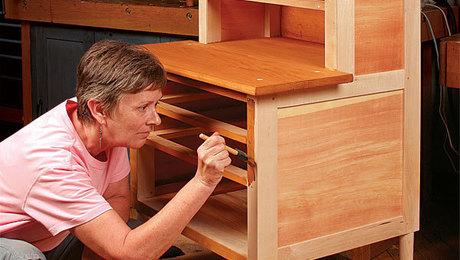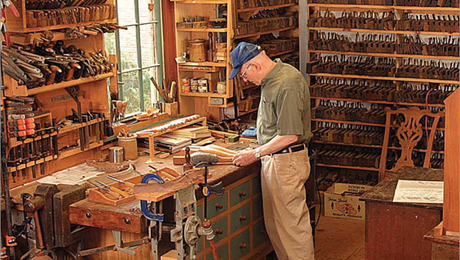Unpacking furniture history
History is never simple, and that 'Ming Dynasty' chair probably isn't what it seems.
I was recently asked to write a quick condensed-hour course to teach furniture history in order to properly identify “antique” furniture. I politely refused. This brings me to my very favorite topic of discussion within wooden furniture history: unrealistic expectations. It’s not something I am encouraged to talk about openly, but I regularly witness popular expectations based on rumor and far from reality. I frequently spend hours unpacking something a client presents as innocuous fact. In some cases, it is easier to identify which pieces are not antiques.
A client might approach me with, “This table is solid French walnut! It’s extremely old, don’t you know?” Now maybe the style fits an 18th-century French form, so the idea of French and walnut are not wholly incorrect. However, one look underneath shows the substrate to be MDF, which appeared in the mid-20th century so “solid walnut” and “extremely old” disappear out the proverbial window. I want to ask, “And who told you this?”
Asking the important questions
In my little world of woodworking, restoration informed by conservation, there is no basic methodology to condense “furniture” into a simple history. Because history is never simple. Delineating a development of wooden furniture begets the notion that progress is linear, which it is not. Asking for a quick history of furniture is akin to asking for a quick history on art, music, or medicine. These things do not exist in a vacuum. Wooden furniture, whether a decorative art or vernacular object, is the complicated result of skill, trade, and timber. Throw in linguistics, geography, colonization, trade routes, labor, politics, and don’t forget trees.
Restorers and conservators assess a piece in not only aesthetic style, but wood species, joinery, type of hardware, chemical composition of the finish, current geographic location, even the type of glue. Are there makers’ marks? Records of sale? Receipts of manufacture? Did this piece appear in a well-known estate of a noble family and does it match the diary entries of a royally appointed cabinetmaker? Or was it found in a skip on the side of the road?
The truth behind many antique pieces
Wood identification and geography are excellent starting points to look at furniture. In truth, they often offer more questions than answers. Dendrochronologists and historians can spend their whole careers in the pursuit of wood species identification. Some species are impossible to distinguish without exciting and expensive techniques and equipment, like gas chromatography and microtomes.
It is also important to note that sometimes a “wood description” is actually a stain color: a purple called “mahogany,” for example. I have repaired many a piece with an aesthetically Chinese style. These reproductions frequently appear in deep violet colors. The client confidently says “This is Ming dynasty mahogany.” However, true mahoganies [Swietenia spp] are never deep purple. In many Chinese pieces of note, that purple timber is often a totally different species called Zitan [Pterocarpus santalinus].
We have yet to mention the socio-political history of the use of mahogany lumber. Swietenia species are historically wrapped up in naval production, not to mention historical growth relegated to Central and South America. As I complete repairs to the alleged Ming dynasty chair, I find that the wood is maple and that deep purple is a heavily toned lacquer. The wood, toned lacquer, and machine-made carvings indicate this is a 20th century manufactured reproduction of a historic form. Geographically, this was found in a dumpster in the Southwest United States. Is it likely that this purple-stained maple chair was created in China before the 17th century? Not really.
Setting the record straight
A “history of furniture” would be a narrative of wooden objects as a monolith. There will always be exceptions found to any quick rules: Phrases I have heard, such as “All 17th century furniture was finished in wax.” This is decidedly untrue. Or something like “Linseed oil was the only finish ever used in the beginning of the North American colonies.” Also, completely inaccurate.
Woodworking is so excitingly diverse. Why bother trying to boil it down? It is easy to forget that the small histories we have in writing don’t always acknowledge the histories that weren’t.
Digging deeper
I am guilty of past participation in a click-bait internet where headlines and titles are meant to draw one in. Seven tips to help you lose fat. Five hacks to help you get your life together. Many online auctions and “antique dealers” label things in this way without authenticity: titles in bold print read “English 18th century” or “French Gothic Oak.” Often, this only refers to construction “in the style of” or “in the manner of,” not a true time period. I encourage furniture lovers to look critically at simplified generalizations.
My normal advice to woodworkers who love history is to question everything. Whose narrative is this? For efficiency’s sake, I’ve provided a few tips to help identify antiques.
Three best tricks to identify antique furniture:
- Flip the piece upside down.
- Remember that furniture does not exist in a vacuum.
- Stop looking for quick tips to identify antique furniture.
For more information on identifying the period styles and forms you enjoy, have a look at decorative art histories from the time periods you love. Check out museum catalog handbooks – they often include delicious information about the lives of a piece or the restoration it took to keep it in the collection. For book nerds, enjoy Charles Hayward’s book Antique or Fake? The Making of Old Furniture. Or another one, Cescinksy’s The Gentle Art of Faking Furniture.
 |
Survival of the Prettiest |
 |
Re-creating a Shaker Finish |
 |
A Workshop Steeped in History |
















Log in or create an account to post a comment.
Sign up Log in